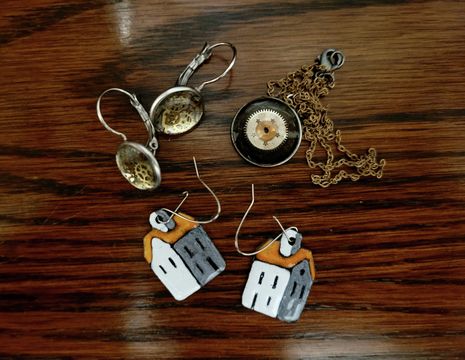The unassuming weight of jewellery
Annia Krzoska reflects on the meaningful role that jewellery plays in shaping our outfits and serving as a means of expressing our identities

In the hectic landscape of student life, consistency and familiarity prove to be rare blessings. For many of us, our favourite pieces of jewellery become not just parts of our outfits, but essential elements of ourselves that stay with us through all of our experiences.
Jewellery helps us to express our internal identities. Handmade earrings take many shapes, with more options and flexibility for expression than a standard outfit could hope for. Some Etsy sellers make custom book and album earrings, allowing the wearer to express their love for an artist in a way more subtle than a band T-shirt or tote bag. Earrings allow the person to carry their interests anywhere. Through fun ornaments, individuals can add familiarity to their outfit in unfamiliar settings. During an internship, you might add a splash of fun to your business outfit with a pair of neon green dinosaur earrings. Using earrings, you can subtly add colour to what might otherwise have been a plain outfit without violating dress codes or uniform rules.
“Through fun ornaments, individuals can add familiarity to their outfit in unfamiliar settings”
While thinking about the significance of jewellery, I spoke to one student, Lisa, who acutely felt the intersect between her Turkish culture and her feelings about adornation. She argued that our favourite pieces of jewellery are more than simple accessories. Referencing the Turkish language, she described accessories as “something that you remove at the end of the day,” like a bag or a belt. Adornation, meanwhile, is associated more with custom and is more commonly used to describe jewellery. It is customary for newborns to be gifted a gold bracelet (or another item of jewellery), for instance. From their birth to the point when they outgrow them, these pieces become part of the child’s daily wear. Here, jewellery almost becomes part of the individual. While ornaments certainly add more to outfits, their connection to custom and tradition gives them a deeper meaning. As such, our favourite pieces of jewellery belong to a separate category than belts, gloves and bags.

Having purchased a beaded bracelet from a tourist shop in Vienna, I found that after months of everyday wear, the individual beads would provide comfort throughout Cambridge’s many challenges. When it eventually broke, I immediately sought a replacement to return that unassuming weight to my wrist. Without it, I felt part of me was missing. Likewise, When Lisa first moved to Cambridge, the ring on her finger gained new significance. “It symbolised continuity in a very subtle way ... when everything is entirely different for the first time, it feels important to have had a quiet, subtle and unassuming reminder of continuity.” Through good and bad, jewellery stays with the individual. Jewellery can carry memories, provide comfort, become something to fiddle with when bored, and pull an outfit together. Lisa described her ring as “an unassuming weight,” which she defined as “the feeling of a piece of jewellery that has just become part of you.” When you wear something every day, you stop noticing its presence until it’s gone, and this struck a chord with my own experiences regarding my bracelet.
“Jewellery almost becomes part of the individual”
Jewellery also holds simple sentimental value. While for some their favourite jewellery piece might be a family heirloom, a necklace purchased from a charity shop three months ago can still carry a similar “unassuming weight” to a ring passed down through three generations. Maybe gifted jewellery is more likely to provide that personal, sentimental connection, but it is certainly not a prerequisite. Sometimes, a cheap woven bracelet becomes as essential to a person’s daily life as a pair of earrings gifted by a close relative or significant other. Once a person grows attached to a piece of jewellery it begins to mould to the wearer. Its absence is noticeable when it is not worn. The bracelet might not be inherently significant, but it becomes symbolic to the individual as a representation of continuity, familiarity and comfort. Of course, not all items of jewellery become part of us. A fake pearl necklace worn once to a May Ball can be easily removed and forgotten about. However, when a piece of jewellery is there with you for weeks at a time, it is difficult to reduce it to mere accessory.
Our favourite jewellery pieces are more than accessories; they are part of our identities and provide comfort to us in unfamiliar places. Without them, we feel exposed, underscoring just how important they can be to us. Definitely more so than just an accessory.
 News / CUP announces funding scheme for under-represented academics19 December 2025
News / CUP announces funding scheme for under-represented academics19 December 2025 News / Cambridge welcomes UK rejoining the Erasmus scheme20 December 2025
News / Cambridge welcomes UK rejoining the Erasmus scheme20 December 2025 Comment / Yes, I’m brown – but I have more important things to say22 December 2025
Comment / Yes, I’m brown – but I have more important things to say22 December 2025 News / SU reluctantly registers controversial women’s soc18 December 2025
News / SU reluctantly registers controversial women’s soc18 December 2025 Film & TV / Timothée Chalamet and the era-fication of film marketing21 December 2025
Film & TV / Timothée Chalamet and the era-fication of film marketing21 December 2025









